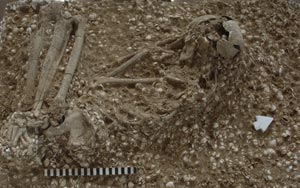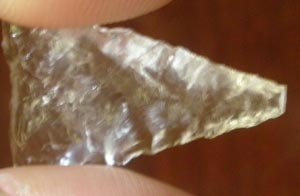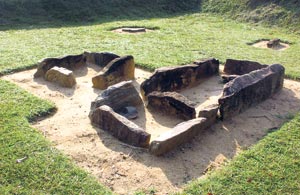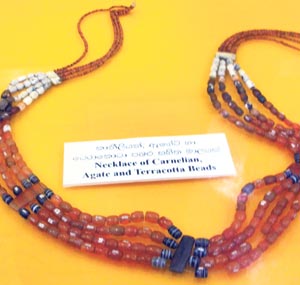A good friend of mine told me that over 40 years ago, one of his friends alleged that when he applied to the Archaeology Department to permit an excavation on land owned by him in Pomparippu, he was refused with the excuse that it was not in the best interest of the nation to investigate a civilization that maybe older than Vijaya.
Maybe Lankans had a psychological barrier to being proud of this older civilization. I am glad that this is no longer seen as a problem and the proto-history of Lanka is being revealed in a burst of discoveries.
 |
| Menik Hamy dated back to 4000 years ago |
Unearthing life 4000 years ago...
Our journey began with the complete skeletal remains found in the coastal village of Minie-Ethiliya in the Magampura district that have been carbon dated to 4000 years ago. The skeleton had been laid to rest in a foetal position with the head to the north, and covered with a large quantity of shells. Excavations were done by Dr. Nimal Perera of the Archaeology Department. Named Menik Hamy, the skeleton is now on display just as it was found except for orientation, at the new Museum constructed in the Star Fort in Matara, a nice little museum which is well worth a visit the next time you pass through Matara.
In 2007, a few clay graves were found and excavated by Prof. Raj Somadewa of the Post Graduate Institute of Archaelogy (PGIAR) at the Rancha Madama School premises, a few km off the A18, south of Embilipitya.
It has been carbon dated to 3300 years ago. A foundation of an ancient house was also found on the premises of the Sri Jayabodharama Vihara on the hill behind. This was reported in September 2009 and has now been also dated to the same period.
It is the oldest site in Sri Lanka with metal tools and is from the transition of the Stone Age to the Agricultural Age. Stone tools, grinding stones, red and black ware and metal tools were unearthed.
When I visited the excavation at the school about three weeks ago it had been refilled, with just the top of the clay graves walls exposed. A large temporary shed had been built over the site for protection. But a new school building had been constructed at a distance, to be able to demolish the old building and extend the excavation. A watcher we met at the site was motivated to give the site the protection it needed.
Asking directions we then travelled to the Vihara in Udaranchamadama. The foundation of the ancient house was sadly exposed and threatened by rainwater gushing over it from the hills behind. The temporary shed had been removed. The young monk in the Vihara was not very interested in the archaeological site and probably saw it as a threat to the sanctity of the vihara he was trying to develop.
Even after one year, the Department of Archaeology, has still not moved to gazette and protect the foundation of this ancient house.
 |
| Microlith |
Currently excavations are being done by Prof. Somadewa at Haldulmulla, just off the A4 at about 179 km on the side road towards the Haldulmulla Tamil School. It was the media publicity about Rancha Madama that prompted villagers who had known about this grave yard for many decades to bring this site to the attention of the PGIAR. Some of the graves had got covered by the tarred road to the school which needed to be removed.
The site has yielded a number of clay graves of various sizes. The skeletons of the dead were brought and laid in these clay graves and firewood was piled over them, covered with clay and set on fire. The size of the rectangular grave was based on the number of pots with ashes of the dead that were interred in it, from just two pots in a small grave, upto 30 in a large grave.
From the similarity to clay graves at Rancha Madama they are expected to be from the same era. The most spectacular find from this excavation has to be the beautiful Microlith with a triangular shape that was discovered in a small grave close to the school wall.
 |
| Ibbankatuwa burial site |
South of Dambulla, the ancient megalithic burial site at Ibbankatuwa, carbon dated back to about 2600 years ago was identified in 1970 and excavated in the 1980's. This accessible site is walking distance from the main road around 86 km on the A6.
The graves here are made with large flat stone slabs. A grave made with clay used for cremation and for interment of ashes was also found at Ibbankatuwa and has now been filled in for protection. Very interesting artifacts including a beautiful bead necklace which were found in these graves are on display at the small archaeology museum of the Kelaniya University.
 |
| The beautiful necklace found at
Ibbankatuwa |
Even this classic site which should clearly be added to the standard itinerary of a ruined cities tour, has not been signposted well to guide visitors. It also lacks even a basic ‘on site panel’ to explain its significance, and the artifacts discovered.
Similar graves have also been discovered in many other sites around Lanka - Pomparippu in Wilpattu, Gurugalhinna in Gampola, Gedige in Anuradhapura etc. The ancient proto history of Lanka, the tribes of Queen Kuveni, who were in the island when Vijaya landed, were clearly a mature civilization, about which we have so far studied so little, as part of our ancient culture.
Fourteen thousand years ago with the last Ice Age just ending, most of the Northern Hemisphere was still covered in ice, and the sea level was 120 metres below its current level. Lanka was part of the continuous land mass of the Indian peninsula.
A study of fossilized pollen by Dr T. R. Premathilake of the Post Graduate Institute of Architecture has shown that oats and barley were being cultivated in the Horton Plains during that era.
Over the next 7,000 years the earth warmed and the sea level rose to the current level and Lanka became an island.
Recent excavations in many parts of Lanka appear to show that more than 4000 years ago the inhabitants of the island had a developed social structure.
(The writer is currently
following a postgraduate diploma in Museology at the Post Graduate Institute of Archaeology (PGIAR) of the University of Kelaniya)
|





